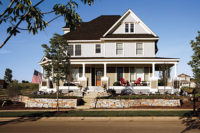Given their name, it’s completely reasonable to assume that rainscreens are a key part of waterproofing buildings. Truth is, rainscreens do play a crucial role in waterproofing buildings by employing a multi-layered approach to managing moisture intrusion. But they don’t do it all. Let’s take a closer look at the role rainscreens play.
First, it is important to understand what the definition of a rainscreen system is. As defined by the Rainscreen Association in North America and adopted by the most recent International Building Code, a rainscreen is an assembly applied to an exterior wall which consists of, at minimum, an outer layer, an inner layer, and a cavity between them sufficient for the passive removal of liquid water and water vapor. Let’s break this down:
1. Drainage: This is reference for removal of liquid water by gravity. This is one of the key differences between a rainscreen system and a more traditional cladding approach. The presence of an air cavity between the exterior cladding and the building's water-resistive barrier allows any water that penetrates the cladding (due to wind-driven rain, for example) to drain out through holes at the bottom of the cavity, preventing the bulk of the water from reaching the structure and WRB.
2. Ventilation: This is the second key difference a rainscreen system has versus a more traditional cladding approach. This addresses the passive exchange of air between the cavity and exterior to facilitate the removal of water vapor. Typically, ventilation is achieved with openings at the top and bottom of a wall assembly, allowing air to flow in one and out the other. This contrasts with venting, where an opening is only at the top or bottom of a wall assembly. This still allows for air to flow, but to a significantly lesser volume since the air must move in and out of the same opening. Vented wall assemblies most commonly have an opening at the bottom so drainage may also occur. The result is moisture that might get trapped behind the cladding, within the cavity, will be passively removed. This reduces the risk of moisture build-up within the wall assembly, which can help prevent issues like mold growth, deterioration of materials or rot.




Even when the cladding system experiences minor leaks or imperfections, which is certain with a rainscreen, the assembly creates a secondary line of defense by channeling water away from the buildings WRB. This redundancy provides increased assurance against water intrusion compared to traditional cladding systems.
One commonality a rainscreen approach shares with traditional cladding assemblies is the cladding itself. Whether in a rainscreen or a traditional system, the cladding material must possess durability and weather resistance to ensure the integrity and longevity of the WRB and other building envelope systems. In a rainscreen assembly, the cladding is particularly important as it forms the visible, aesthetic layer of the system while also serving as the primary water-shedding surface. With less water in contact with the WRB, risk can be mitigated.
Benefits of Rainscreens with Waterproofing:
- Superior performance: Compared to traditional methods, rainscreens offer enhanced protection against water intrusion, especially in challenging weather conditions with ventilation and drainage playing key roles.
- Durability: By separating the cladding from the waterproofing, the “hard candy shell” will provide shielding from environmental elements such as physical interaction, wind borne debris and sunlight.
- Design flexibility: Rainscreens offer a wider range of design possibilities compared to traditional cladding, allowing for more architectural freedom.
Overall, rainscreens provide a valuable tool for achieving and maintaining reliable waterproofing in buildings, offering significant advantages in terms of performance, durability, and design flexibility. As for their role in waterproofing, there are a few considerations.
- Not a bulletproof solution: It is possible for a rainscreen to be overwhelmed by heavy rain, wind-driven moisture, clogged weep holes or simply improper design.
Design and installation are critical: Improper detailing or construction flaws can compromise their effectiveness (see point number 1).
- Cost difference: Depending on the material and system complexity, a rainscreen system can be greater in initial cost than a traditional assembly but their resilience and durability often justify their initial cost.
- Added Insulation: Rainscreen systems typically allow for a layer of exterior insulation to be added to the wall assembly—this can enhance the assembly’s performance in many ways, especially if the waterproofing layer’s temperature cycling is reduced or even eliminated—furthering the walls resilience.
With proper consideration, a rainscreen assembly will enhance the exterior walls’ performance in many ways, notably regarding its added benefits to combating water infiltration and contributing to the long-term durability of the building’s envelope.







